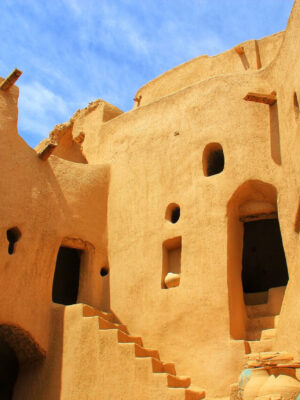Gonbad-e Qabus
This tomb tower was built by Shams Ol Ma’ali Qabus Ibn- e Voshmgir of the Ziarid dynasty. Despite his obligation to implement violent measures for the protection of his Gorgan rule, he was a knowledgeable man who highly valued science, poetry and literature. During his reign, the city of Gorgan was called “Dar Al Elm”, meaning ‘home of science’.
Gonbad-e Qabus tomb tower is situated near the old capital city of Jorjan, in what is today the town named Gonbad-e Qabus. This brick tomb tower was intentionally built on an artificial hill at the height of 15 meters above the ground to serve a special purpose. The construction of this tomb tower had to extend into the hill due to the technical and security aspects that were the architectural requirements of the structure; however, it is believed that building the tower on an artificial platform (the plain) also served a syncretic purpose. The height of the tower soars to 55 meters from the plain to the peak of its conical roof. The height of the tower together with the 15- meter elevation of the plain reaches 70 meters.

Gonbad-e Qabus comprises a base, a body, and a conical roof which rests on top of the structure, all in proportional balance. The high quality structure is a witness to the history and geography of this area, having survived various damages; it is referred to as a ‘memorial from the past.’ The foundation of the tomb tower is made of red baked bricks and a traditional Iranian concrete called sarooj. The outer diameter of the construction is 17.8 meters at the top. The tomb tower has two calligraphic inscriptions in Kufic that introduce Qabus. The conical roof with the height of 18 meters has been perfectly built on the top of the decagonal star-shaped plan.
There are different theories about the function of this structure, but the inscriptions give no clue about it. In 1988, Russian archaeologists made excavations to find a body in it to no avail. According to some legends, Qabus was buried in a glass coffin, hanging from the middle of the roof by chains so that enemies could not have access to him. However, it neither seems logical nor does it serve as a proper burial for a Muslim. Nevertheless, one can postulate that the tower was erected to serve as a guiding minaret for travelers.
Gonbad-e Qabus
This tomb tower was built by Shams Ol Ma’ali Qabus Ibn- e Voshmgir of the Ziarid dynasty. Despite his obligation to implement violent measures for the protection of his Gorgan rule, he was a knowledgeable man who highly valued science, poetry and literature. During his reign, the city of Gorgan was called “Dar Al Elm”, meaning ‘home of science’.
Gonbad-e Qabus tomb tower is situated near the old capital city of Jorjan, in what is today the town named Gonbad-e Qabus. This brick tomb tower was intentionally built on an artificial hill at the height of 15 meters above the ground to serve a special purpose. The construction of this tomb tower had to extend into the hill due to the technical and security aspects that were the architectural requirements of the structure; however, it is believed that building the tower on an artificial platform (the plain) also served a syncretic purpose. The height of the tower soars to 55 meters from the plain to the peak of its conical roof. The height of the tower together with the 15- meter elevation of the plain reaches 70 meters.

Gonbad-e Qabus comprises a base, a body, and a conical roof which rests on top of the structure, all in proportional balance. The high quality structure is a witness to the history and geography of this area, having survived various damages; it is referred to as a ‘memorial from the past.’ The foundation of the tomb tower is made of red baked bricks and a traditional Iranian concrete called sarooj. The outer diameter of the construction is 17.8 meters at the top. The tomb tower has two calligraphic inscriptions in Kufic that introduce Qabus. The conical roof with the height of 18 meters has been perfectly built on the top of the decagonal star-shaped plan.
There are different theories about the function of this structure, but the inscriptions give no clue about it. In 1988, Russian archaeologists made excavations to find a body in it to no avail. According to some legends, Qabus was buried in a glass coffin, hanging from the middle of the roof by chains so that enemies could not have access to him. However, it neither seems logical nor does it serve as a proper burial for a Muslim. Nevertheless, one can postulate that the tower was erected to serve as a guiding minaret for travelers.





















